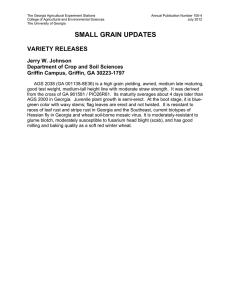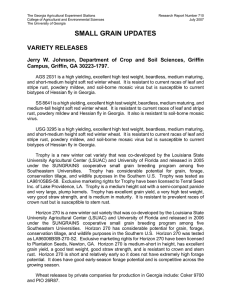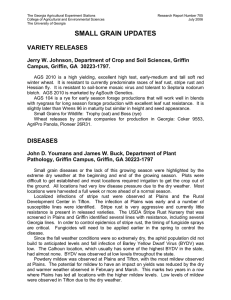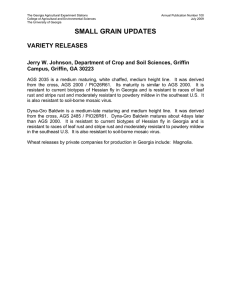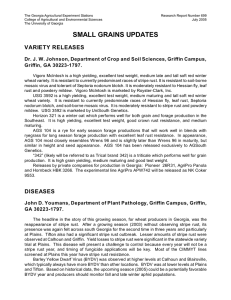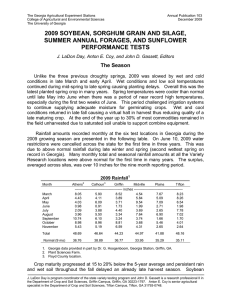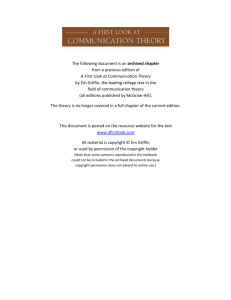Document 13150612
advertisement
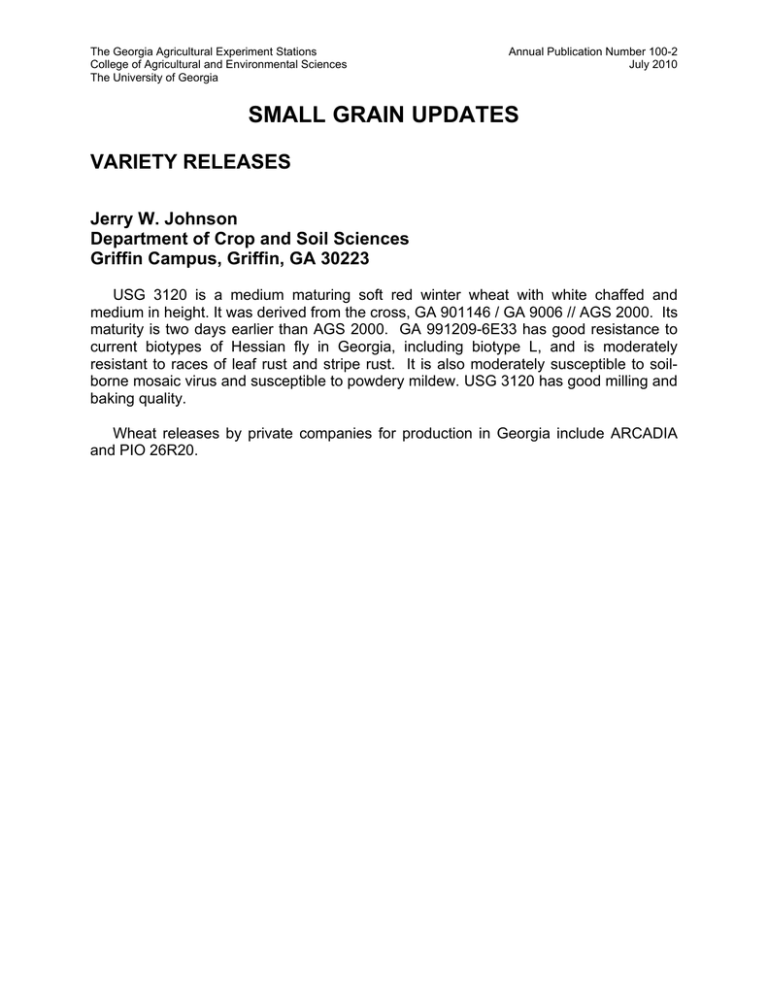
The Georgia Agricultural Experiment Stations College of Agricultural and Environmental Sciences The University of Georgia Annual Publication Number 100-2 July 2010 SMALL GRAIN UPDATES VARIETY RELEASES Jerry W. Johnson Department of Crop and Soil Sciences Griffin Campus, Griffin, GA 30223 USG 3120 is a medium maturing soft red winter wheat with white chaffed and medium in height. It was derived from the cross, GA 901146 / GA 9006 // AGS 2000. Its maturity is two days earlier than AGS 2000. GA 991209-6E33 has good resistance to current biotypes of Hessian fly in Georgia, including biotype L, and is moderately resistant to races of leaf rust and stripe rust. It is also moderately susceptible to soilborne mosaic virus and susceptible to powdery mildew. USG 3120 has good milling and baking quality. Wheat releases by private companies for production in Georgia include ARCADIA and PIO 26R20. DISEASES James W. Buck and John D. Youmans Department of Plant Pathology Griffin Campus, Griffin, GA 30223-1797 Powdery mildew was almost nonexistent this year due to rainfall and cold temperatures. Mildew prefers cool temperatures and damp conditions. Mildew was observed at very low levels at Tifton, but not at Griffin or Plains. Stripe rust (Puccinia striiformis) was observed at Griffin where plots were artificially inoculated. Stripe rust was found at very low levels late in the season at Plains. No widespread epidemics were observed in the state. Samples were sent to Washington state to confirm the race of rust involved. Barley Yellow Dwarf Virus was observed at high levels across the state. State wheat trials at Tifton, Plains, and Griffin had the highest disease pressure in years, with highest disease levels observed at Plains. Aphids must have continued to be active during the colder temperatures of late winter. The decreased wheat acreage seemed to have an aphid concentration effect on the wheat plots at all locations. Stagonospora leaf and glume blotch were at moderate levels across the state again due to the moist early spring conditions observed. Leaf rust was observed very late in the season but did not pose a serious risk to the crop. The cold and wet conditions of the season should have led to above normal soilborne wheat mosaic virus (SB) and wheat spindle streak mosaic virus (SS) infections. Some soilborne was observed at Griffin. The cold and excessive water may have been too much for the fungal vector (Polymyxa graminis) to infect the wheat roots. The extreme weather of the fall and late winter played a significant role in limiting mildew infections. The two- to three-week period of dry weather in early to mid spring helped to limit stripe rust and leaf rust infections. Additionally, the reduced wheat acreage in the state limited field-to-field movement of foliar disease and further prevented the development of large scale disease epidemics. INSECTS G. David Buntin Department of Entomology Griffin, Georgia The variety tests were sampled for Hessian fly, Mayetiola destructor, in late April, 2010 at Southwest Branch Research and Education Center near Plains, the Bledsoe Research farm near Griffin and at the Lang Farm near Tifton, GA. Results are shown in the next table. Five lines (SL 1001 – SL 1004 and Bilancia) listed at the bottom of the table are hard red wheat types and were only evaluated at Tifton. Hessian fly infestations were low at all locations, making definitive ratings difficult. Several wheat varieties showed good levels of Hessian fly resistance including AGS 2026, AGS 2035, AGS 2060, Jamestown, Pioneer brands 26R31 and 26R61, USG 3592, SS8308 (fair), SS8641, Vigoro Oglethorpe, and a number of experimental lines. Varieties with good resistance in southern Georgia may not be resistant in northern Georgia because of the presence of biotype L in northern Georgia. The only currently available varieties with biotype L resistance are AGS 2010, AGS 2026, and Oglethorpe. Rye and oats also are good Hessian-fly-resistant alternatives to wheat for forage production because rye is highly resistant and oats are immune to the insect. Cold wet conditions in the fall of 2009 prevented most planting of wheat. These conditions also delayed what fields were planted; consequently damaging infestations of Hessian fly were largely avoided. Despite cold conditions during the winter, aphid infestations occurred in numerous fields. Aphids cause direct injury to wheat and also transmit barley yellow dwarf virus (BYDV). BYDV infection was variable but was damaging in some fields throughout most of the state. Although the level of expression of symptoms varies between varieties, no varieties are truly resistant to or tolerant of BYDV infection. Systemic insecticide seed treatments and properly timed foliar applications of insecticides can reduce aphid numbers and minimize BYD incidence. Consult your local county extension agent and 2009 Georgia Pest Management Handbook for a list of recommended insecticides and for management practices for these and other insect pests of small grains. Hessian fly infestation* in wheat entries in the 2009-2010 Georgia State Small Grain Variety Test, Plains, Griffin and Tifton, GA. Entry name Plains % Infested No./stem Griffin % Infested No./stem Tifton % Infested No./stem GA991336-6E9 GA01134-8A6 USG 3555 LA01029D-139-3-C JGL Exp. 72562 30 30 25 25 20 0.30 0.50 0.40 0.35 0.25 0 25 10 35 0 0 0.25 0.35 0.70 0 0 25 0 75 0 0.40 0 2.20 Roberts Panola DynaGro-Baldwin SS8404 GA001170-7E26 15 15 15 15 15 0.35 0.15 0.15 0.40 0.10 0 0 5 5 10 0 0 0.10 0.05 0.10 0 0 5 0 0 0 0.05 0 Pioneer 26R20 JGL Exp. 60172 AGS CL7 USG 3251 NC05-19896 15 15 15 15 15 0.25 0.15 0.40 0.15 0.15 5 15 0 0 0 0.05 0.30 0 0 0 0 20 5 20 15 0 0.35 0.05 0.25 0.20 Trical 2700 (triticale) NCPTO1-1433 USG 3592 USG 3295 NK-Coker 9700 10 10 10 10 10 0.20 0.10 0.10 0.10 0.25 0 0 10 5 0 0 0 0.25 0.05 0 0 25 5 0 0.45 0.05 Jamestown Progeny 117 Merl TV8589 GA011174-8A9 10 10 10 10 10 0.10 0.20 0.20 0.20 0.10 0 0 0 0 0 0 0 0 0 0 0 30 25 5 5 0 0.45 0.40 0.10 0.20 GA011124-8LE28 JGL Exp. 51585 LA01139D-86-6-2 GA02343-9LE5 GA03564-9EE42 10 10 10 10 10 0.10 0.15 0.35 0.15 0.10 0 5 0 0 0 0 0.10 0 0 0 25 0 15 - 0.25 0 0.15 - TVX8581 USG 3452 USG 3438 Magnolia LA01110D-150 10 10 5 5 5 0.10 0.10 0.15 0.15 0.10 10 0 0 10 10 0.20 0 0 0.15 0.10 5 30 60 5 0.05 0.35 1.25 0.05 USG 3770 Progeny 166 Progeny 185 GA031238-7E34 GA011493-8E18 5 5 5 5 5 0.05 0.05 0.05 0.05 0.05 25 5 0 0 0 0.35 0.05 0 0 0 5 15 20 10 10 0.10 0.20 0.30 0.10 0.20 GA021338-9EE11 GA021338-9E4 SS8308 USG 3665 NF96210 5 5 5 0 0 0.15 0.05 0.05 0 0 0 5 0 10 10 0 0.05 0 0.10 0.15 0 0 0 - 0 0 0 - Hessian fly infestation* in wheat entries in the 2009-2010 Georgia State Small Grain Variety Test, Plains, Griffin and Tifton, GA (Continued) Entry name Plains % Infested No./stem Griffin % Infested No./stem Tifton % Infested No./stem SS520 GA00067-8E35 Pioneer 26R31 USG 3120 Oglethorpe 0 0 0 0 0 0 0 0 0 0 5 5 5 5 5 0.10 0.05 0.10 0.10 0.05 5 10 0 0 0 0.05 0.15 0 0 0 GA00219-8E45 GA021773-9EE21 Progeny 125 NK-Coker 9553 LA841 0 0 0 0 0 0 0 0 0 0 5 5 0 0 0 0.05 0.05 0 0 0 20 10 5 0.40 0.15 0.05 Pioneer 26R61 DH-100 Fleming USG 3592 SS8641 0 0 0 0 0 0 0 0 0 0 0 0 0 0 0 0 0 0 0 0 5 0 0 0 0.05 0 0 0 AGS 2026 AGS 2060 AGS 2035 TVX8861 TV8558 0 0 0 0 0 0 0 0 0 0 0 0 0 0 0 0 0 0 0 0 0 0 0 0 0 0 0 0 0 0 LA01110D-84-1-C GA001138-8E36 GA011027-8LE24 Arcadia (D05*6441) LA0110D-84-2-C 0 0 0 0 0 0 0 0 0 0 0 0 0 0 0 0 0 0 0 0 0 0 0 0 0 0 0 0 0 0 GA021338-9E15 GA021245-9E16 GA001142-9E23 GA021087-9LE33 GA011446-9LE35 0 0 0 0 0 0 0 0 0 0 0 0 0 0 0 0 0 0 0 0 0 0 0 0 0 0 0 0 0 0 LA821 SL 1001 SL 1002 SL 1003 SL 1004 0 - 0 - 0 - 0 - 0 0 0 5 0 0 0 0 0.10 0 Bilancia - - - - 10 0.15 *Results from single non-replicated block.

